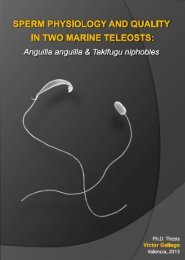TESIS DOCTORAL - RiuNet - Universidad Politécnica de Valencia
TESIS DOCTORAL - RiuNet - Universidad Politécnica de Valencia
TESIS DOCTORAL - RiuNet - Universidad Politécnica de Valencia
You also want an ePaper? Increase the reach of your titles
YUMPU automatically turns print PDFs into web optimized ePapers that Google loves.
Chapter 1<br />
A B<br />
C D E<br />
F G H I<br />
Figure 1.2. A, Conidiophores of Ilyonectria lirio<strong>de</strong>ndri; B, Macro- and microconidia of I. lirio<strong>de</strong>ndri; C,<br />
Chlamydospores in chains of “Cylindrocarpon” pauciseptatum; D, Conidiophores of Campylocarpon<br />
fasciculare (Halleen et al., 2004); E, Macroconidia of Campyl. fasciculare (Halleen et al., 2004); F,<br />
Penicillate conidiophores of Cylindrocladiella parva; G, Terminal vesicles of Cyl. parva; H, Conidia of<br />
Cyl. parva; H, Chlamydospores in chains of Cyl. parva. Scale bars: a-c, f-i = 10 µm; d = 50 µm; e = 30<br />
µm.<br />
In this sense, Halleen et al. (2003), conclu<strong>de</strong>d that black-foot pathogens from<br />
soils infected grafted grapevines once planted in open-rooted nurseries, whereas these<br />
pathogens rarely occurred in rootstock propagation material prior to planting. During<br />
the grapevine propagation process, at the time of planting, the susceptible basal ends<br />
(especially the pith area) of most of the nursery cuttings are partly or even fully<br />
exposed, and the young callus roots also break during the planting process, resulting in<br />
small wounds susceptible to infection by soilborne pathogens. Thus, the occurrence of<br />
black-foot pathogens in the graft union might be explained by the nursery practice of<br />
20

















